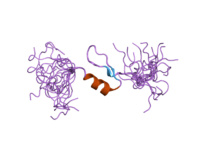
Photo from wikipedia
ETHNOPHARMACOLOGICAL RELEVANCE Agriophyllum squarrosum (L.) Moq. is a traditional Mongol medicine generally used to treat diabetes. OBJECTIVE To investigate the protective effects and potential mechanisms of Agriophyllum oligosaccharides (AOS) on… Click to show full abstract
ETHNOPHARMACOLOGICAL RELEVANCE Agriophyllum squarrosum (L.) Moq. is a traditional Mongol medicine generally used to treat diabetes. OBJECTIVE To investigate the protective effects and potential mechanisms of Agriophyllum oligosaccharides (AOS) on liver injury in type 2 diabetic db/db mice. MATERIALS AND METHODS The db/db mice were divided into the model group (Model), metformin group (MET), high-dose AOS group (HAOS), and low-dose AOS group (LAOS). Nondiabetic littermate control db/m mice were used as the normal control group (Control). Mice in AOS groups were treated with AOS (380 or 750 mg/kg) daily, for 8 weeks. At 8 weeks, blood samples were collected to detect lipid and enzyme parameters concerning hepatic function, including alanine aminotransferase (ALT), aspartate aminotransferase (AST), total protein (TP), albumin (ALB), globulin (GLB), triglyceride (TG), total cholesterol (TC), and high-density lipoprotein cholesterol (HDL-C). Random blood glucose (RBG) test, oral glucose tolerance test (OGTT), and oral maltose tolerance test (OMTT) were also conducted. Microscopy was used to observe morphological changes in the liver of AOS-treated groups. Real-time PCR was used to detect the mRNA expression, including insulin receptor substrate 2 (IRS-2), phosphatidylinositol 3 kinase (PI3K), protein kinase B (AKT), peroxisome proliferator-activated receptor (PPAR)-γ, insulin receptor (INS-R), and Glut4. Furthermore, western blotting was performed to identify proteins, including phosphorylation of IRS-2 (p-IRS-2), PI3K, p-AKT, PPAR-γ, INS-R, and Glut4. Hepatic protein expression of p-IRS-2, PI3K, p-AKT, PPAR-γ, INS-R, and Glut4 was observed using immunohistochemical staining. RESULTS AOS treatment significantly decreased RBG, OGTT, and OMTT in mice, as well as serum ALT and AST activities. AOS groups demonstrated significantly higher expressions of p-IRS-2, PI3K, PPAR-γ, p-AKT, INS-R, and Glut4 protein and IRS-2, PI3K, AKT, PPAR-γ, INS-R, and Glut4 mRNA in the liver tissue of db/db mice; the degeneration and necrosis of hepatocytes and formation of collagen fibres markedly reduced, improving the structural disorder in the liver. CONCLUSION The results suggest that AOS could protect the liver in type 2 diabetes, in part by activating insulin in the INS-R/IRS2/PI3K/AKT/Glut4/PPAR-γ signal pathway, facilitating hepatocyte proliferation, and further reducing the blood glucose levels.